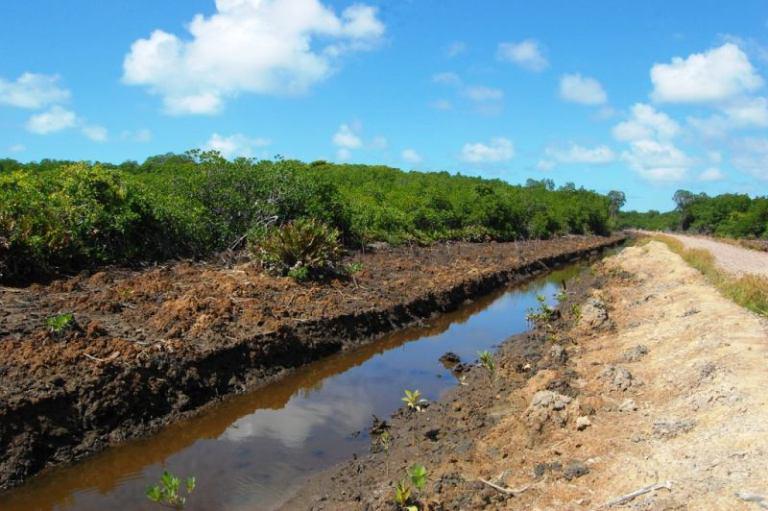
Mangrove Rehabilitation a Triple Win
Fiji has over 46,600 hectares of mangrove forests. Mangroves are state-owned resources that are invaluable as nature’s shield against cyclones, ecological disasters and as the protectors of shorelines. Mangrove systems also provide breeding and nursery grounds for a variety of marine animals, harbour a variety of life forms like invertebrates, fish, amphibians, reptiles, birds and even mammals. The mangroves also purify the water by absorbing impurities and harmful heavy metals and absorb pollutants from the air.
About the Mangrove Rehabilitation Project
A joint mangrove rehabilitation project between the International Tropical Timber Organisation (ITTO) and the Fijian Government sought to address the problem associated with overpopulation and pressure on resource exploitation within the coastal and mangrove wetlands in the provinces of Rewa and Tailevu.
This 6-year project focused on building community capacity to apply Sustainable Forest Management (SFM) practices, revive and strengthen the use of traditional knowledge, rehabilitate degraded areas and support policy and the legal framework to better manage coastal forests and restore not less than 100ha of degraded mangrove areas.
Pilot Villages
The villages of Muanaira and Narocake in the Rewa Province and Natila, Waicoka, Naivakacau and Nasilai Village in the Tailevu Province were identified as pilot sites for the mangrove rehabilitation project.
From the outset, expected outputs included community empowerment to undertake sustainable management at the community level, improvement of the quality of the existing ecosystem, strengthening the up-keep of traditional knowledge and skills among community members to support sustainable resource use.
Alternative Livelihoods
To ease the pressure on the coastal and mangrove wetland resources, alternative livelihood community projects were established within the 6 villages and managed by community members.
Aquaculture
With technical advice and assistance from the Ministry of Fisheries, aquaculture ponds for prawn and tilapia production were established on non-arable swamp communal land in Waicoka, Naivakacau, Natila and Narocake villages. Each pond was stocked with either 10,000 prawn post larvae or tilapia. Narocake had its first harvest of prawns and tilapia in March 2020 and has been restocked with 10,000 prawn post larvae for their second cycle of Prawn farming.
Pig-Rearing
In Nasilai, a community Piggery Farm Project was set up with 3 different breeds of piglets (Large White, Land Race and Duroc). The village Project Management Committee is responsible for overseeing the management of the piggery including cleaning, feeding and purchasing of pig feed.
Apiculture (Beekeeping Project)
A beekeeping farm was set up with 20 double-storey boxes in Muanaira in November 2020. At the second training on 19th November, the village committee were delighted to note that one week after the installation, five boxes were already filled with honey. Income generated from the farm will be invested in community infrastructure, social services and meeting the collective needs of the Vanua and church.
Sewing Machine Training and Financial Literacy
At the completion of their sewing machine training at the Fiji National University (FNU) in November 2020, the 30 member women’s group each received FNU Accredited Certificates and 5 sewing machines for each village. The women learnt to sew Sulu Jaba for women and Bula shirts for men as well as pillow case, bed sheets, door mats.
Project Impact
Since October 2015, the protection of mangrove forests from illegal fuelwood harvesting and targeted mangrove reforestation and rehabilitation work from this ITTO-Fijian Government project has resulted in the return to the area of more fish such as Damu and Yawa and birds like Belo Dravu.
Apart from the rehabilitation of the mangrove forests in the Rewa Delta, project staff engaged with individuals, corporate organisations, youth and church groups to also rehabilitate mangrove forests at the Nasese Foreshore and at the Tikaram Park in Lami.
The total number of mangrove seedlings planted under the project is 457,250 covering 137.25 ha and thus surpassing the 100ha target. Mangrove seedlings that were planted in the villages in the two provinces including the Suva and Lami foreshores since January 2019 contributed towards Fiji’s 30 Million Trees in 15 Years (30MT15Y) tree-planting campaign.
In addition to mangrove rehabilitation, a Mangrove Management Guideline has been developed to support the communities to better manage their mangrove forests.
The management guideline is aligned to the 2007 National Forest Policy, which aims to introduce an effective mangrove management framework for the Rewa Delta, which could be emulated in other mangrove areas around the country.
The restoration and improved management of mangrove forests in the Rewa and Tailevu provinces is triple win for the people and economy in terms of food security and financial needs, and the environment from a climate change and sustainable resource management perspective